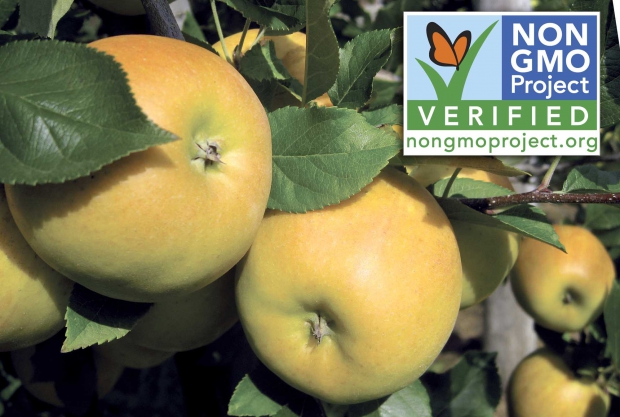
Opal naturally resists browning when cut. FirstFruits was allowed to use the Non-GMO Project logo with the apple. (Submitted photo)
FirstFruits Marketing of Selah, Washington, has announced the Opal apple variety that it markets for Broetje Orchards has been verified as a nongenetically modified organism, in order to distinguish it from a genetically modified apple that is awaiting approval to go onto the market in the United States.
Opal, a yellow-skinned apple, has a natural resistance to oxidation when cut, which means the apples are slow to turn brown.
Keith Mathews, chief executive officer of FirstFruits, said Opal is being heavily promoted through social media and comments by consumers on Facebook alerted the company to the fact that Opal was being confused with another yellow apple, Arctic Golden Delicious, that had been genetically modified to introduce the nonbrowning trait.
“That may have been the genesis for us to say, ‘We need to get in front of this and tell those who enjoy Opal that it’s a great piece of fruit and it’s not modified,” Mathews said.
The Arctic Golden Delicious was genetically modified by Okanagan Specialty Fruits of British Columbia, Canada. The company has also developed Arctic Granny Smith.
The Arctic apples are awaiting nonregulated status from the U.S. Department of Agriculture that would allow them to go to market; the USDA has indicated that it is likely to approve them.
Many U.S. tree fruit organizations and representatives have opposed approving the GMO apples for fear they would have a negative impact on the entire apple market. Among those concerned is Ralph Broetje, the exclusive grower of Opal apples in the United States.
Czech Republic
Opal (cultivar UEB 32642), a cross of Topaz and Golden Delicious, was developed through traditional breeding in the Czech Republic. It has been verified non-GMO by an organization called the Non-GMO Project, whose board members represent retailers of organic and natural foods.
Mathews said it was a lengthy process to obtain the verification, which involved asking the breeding program in the Czech Republic to certify that the variety was naturally bred. Ingredients in the wax formulation used on the apple also had to be verified.
As soon as the announcement hit the press, Mathews was contacted by two retailers that handle a lot of organic foods who were excited about the verification.
“I think theirs was probably a more positive response than I would have thought,” he said.
The verification allows FirstFruits to use the Non-GMO Project logo. Mathews said the company probably won’t put it on stickers on each apple, mainly for logistical reasons, and he doesn’t see an advantage in putting it on the box, but the two retailers intend to use it in point-of-sale materials for Opal.
“I think the message is to the consumer,” he said.
Opal is the first apple to be verified by the Non-GMO Project. Mathews said Opal is the only apple his company intends to verify, even though all U.S. apples are currently non-GMO.
“If we didn’t have the no-browning aspect, if that wasn’t a shared trait, I don’t think we would ever have tried to distance ourselves from the GMO apple,” he said. “Every other apple the consumer can buy is not modified at this point.” •






“Not modified”? Then how did it acquire the trait? Every apple is different because the DNA has been modified.
And how do we know if the opal apple is not from the same RNAi that is found in Arctic Apples? The answer is we don’t and therefore the distinction is false.